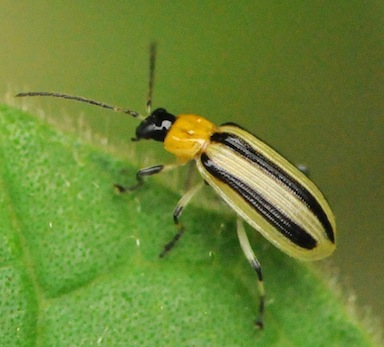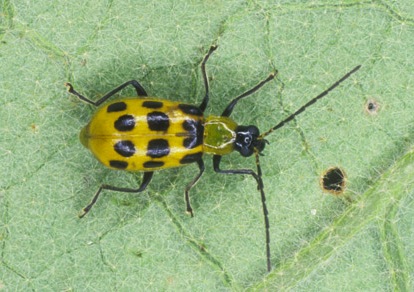Beat The Beetles to Grow Cucumbers
By Ray Novitske, Fairfax Master Gardener
Spotted or striped, these native beetles will wreck havoc with plants in the curcubit family, including squash, cucumbers and melons. There are two different beetles that have similar characteristics. Our striped cucumber beetles (Acalymma vittatum) specialize in cucumber and cucurbit family plants, while spotted cucumber beetles (Diabrotica undecimpunctata howardi) are not as picky and are found on other plants as well. The spotted beetle larva is also known as the Southern corn rootworm, because it likes to attack the roots of corn during the mid-to-late season.

The striped beetle is yellow with three long, black stripes on its back, and a black abdomen. The spotted beetle is slightly larger, yellow or yellowish-green, with 12 black spots on its back. The head is black, and the abdomen is yellow.
Striped cucumber beetles overwinter as adults in ground debris such as dead leaves and plants, and emerge in April to feed and mate. They are especially destructive at this time of year because seedlings are just getting started and are easily damaged. Spotted beetles generally overwinter in the southern states, and head north in late June. However, evidence shows that more are known to stay put for the winter.
 Both beetles lay their eggs at the base of the plant or in the upper cracks in soil. Eggs are oval and pale orange and are laid in groups. They hatch about a week later. Larvae are pale white with dark heads and reach up to 3/8 inch in length, but are rarely seen because they spend their time in the ground feeding on the roots. After two to three weeks, they pupate and emerge.
Both beetles lay their eggs at the base of the plant or in the upper cracks in soil. Eggs are oval and pale orange and are laid in groups. They hatch about a week later. Larvae are pale white with dark heads and reach up to 3/8 inch in length, but are rarely seen because they spend their time in the ground feeding on the roots. After two to three weeks, they pupate and emerge.
The striped beetles have two generations per year with a second brood emerging in September and October here in Virginia. They are found from Canada to Mexico, but are most abundant in their southern range, and not usually a large problem in sandy soils.
Striped cucumber beetles are attracted to the curcubit crops and stimulated by the cucurbitacin chemicals found in the plant tissue. Cucumbers, cantaloupe, all squash, pumpkins, gourds and watermelon will attract them. In addition to the curcubits, spotted cucumber beetles also damage beans, corn, potatoes and peanuts. Adults will feed on the leaves and stems, causing damage and weakness to the plant. Chomping on flowers can reduce fruit production. Chowing down on the fruit produces unsightly scarring.
The most significant danger from both beetles is the spread of bacterial wilt which will kill a plant. Once infected, the plants start wilting as if in need of water and do not easily recover after watering. Wilting starts with one section or leaf and quickly spreads through the entire plant. Cucumbers, summer squash and melons are most susceptible to the bacterial wilt; watermelons not so much. The bacteria can easily be identified by breaking off a wilted area and pulling apart the stem. The bacteria causes a thick, stringy ooze within the stems.
Cultural controls include removing field debris around the ground at the end of a season to eliminate the beetles’ overwinter protection. Rotate crops to different locations each year. Floating row covers keep the insect out of the plants, especially in early spring when plants are most vulnerable. In early spring, lightly till the soil to kill eggs and larvae there. Avoid this pest by planting susceptible crops around June 15, after overwintering adults have emerged and dispersed elsewhere, like to your neighbor’s garden.
‘County Fair’, a pickling cucumber cultivar, has been found to naturally resist the bacterial wilt. Trap crops can give some control, especially in large fields, but may be useless in home gardens. Trap crops are those that the beetles like and where they will congregate, leaving the cash crop alone.
Chemical sprays for foliage include those with naturally-occurring substances such as pyrethrin, kaolin clay, neem or spinosad. Avoid spraying in daytime when blossoms are open to reduce damage to pollinating insects. Use of systemic insecticides, such as imidacloprid containing neonicotinoids, is approved by Virginia Tech for home use, but use of these substances is highly controversial. Absorbed into the plant tissue, neonicotinoids are found to be safer than other chemicals for mammals and birds, but their use has been linked to harming bees and other beneficial insects and pollinators. The best advice is to try the cultural controls first and the more harmful chemicals last.
References
• Cucumber Beetle, Eric Day, Department of Entomology, Virginia Tech, Virginia Cooperative
Extension
• Striped Cucumber Beetle, Virginia Cooperative Extension
• Cucumber Beetles, Corn Rootworms, and Bacterial Wilt in Cucurbit, Cornell University
• Cucumber Beetles – Spotted or Striped, University of Maryland Extension
• Striped and Spotted Cucumber Beetles as Pests of Cucurbits in Michigan, Michigan State University
Extension
… updated 2023